The History of Incino
1892 – 1918: Church and War
1892
The Tombion–Prai d’Incino–Col del Gallo Road was opened to transit, a masterwork of military engineering that is unfortunately semi-abandoned and almost impassable today—which goes by the name Genio Truckway, after the Italian Military Corps of Engineers. It was narrow due to the route’s harsh terrain, but improvements continued until 1915 when the entire length could be covered by fully loaded trucks and artillery trailers.
1900
The year marks the end of a turbulent century. Here is how Don Luigi Moccellin, parish priest of Rocca, Incino, and Corlo, summarizes the era:
The year 1900 concludes the 19th Century. A Century that was tormented by several epidemic and choleric diseases, like in the terrible year of 1836 as well as in 1855 and 1886. Combined with influenza and diphtheria-angina, hundreds of thousands of victims must have been reaped throughout the Kingdom of Italy.
A THOUSAND YEARS = TAN QUAM DIES, QUAE PRAETERIIT (as much as a day gone by)
Twentieth Century
1901
Child mortality devastates Incino in the first year of the century. It starts on January 9 with Celeste Zancanaro, 6 years old. Cause: pagan cough. On July 29, 2-day-old Giovanni Nardino dies from “little development” (meaning he was born underweight). On August 13, Antonio Zancanaro dies at 6 months old; on August 30, Amelia Borsa is next, cause: bronchitis. The year ends with Maria Zancanaro dead on December 4, also from bronchitis.
Rocca’s pastor, when recording the death of a child in the death register, would consistently use this formula: “(First Name, Last Name) … has flown to heaven … cause: …, his tiny corpse was buried in this cemetery on the date of …”
This average of 6 to 7 children dead each year remains constant throughout the first 20 years of the century. Many—too many—would die within 24 hours of birth, and their date of birth was the same as their date of death. For each of those the cause was “imperfect development,” incomplete development. After a year “fragile constitution” was used. However, those who managed to get past 5 or 6 years old had good chances of reaching adulthood.
1903
On January 22, Francesco Borsa died at 75. Borsa was seized by illness in Casere (all the Borsas at the beginning of the century lived in Casere), and died in Tanisoi en route to the hospital in Feltre. The stretcher-bearers didn’t know how to deal with the poor man, who had no place to stay and not a penny to his name. They deposited the corpse in the new church, awaiting arrangements from the health authority, which granted permission for burial after verifying the circumstances of death.
1906
This is the year characterized by many deaths from malnutrition. They are recorded under the heading “slow consumption,” striking both children and the elderly. Linda Zancanaro, 9 months old; Giovanna Borsa, 2 years old; Giovanna Nardino, 84 years old; Tesera Grando, 77 years old, die this way. Under the heading “profession,” all the dead adults are recorded as “farmer.”
1907
This is the year dominated by typhus, which alone causes 6 deaths, all under the age of 25.
1908
This is the year of the consumption. Death carries off Amilcare Zancanaro, 11 months old; Marsilgio Borsa, 3 years old, from slow consumption; Giacomo Zancanaro, 67 years old, from bone consumption; then Benedetto Martinato, 5 years old.
In Primolano, the Veneto railroad finally managed to connect with the Trento–Primolano Austrian line operating since 1896. This sped the way for construction on the Incino–Cismon Road.
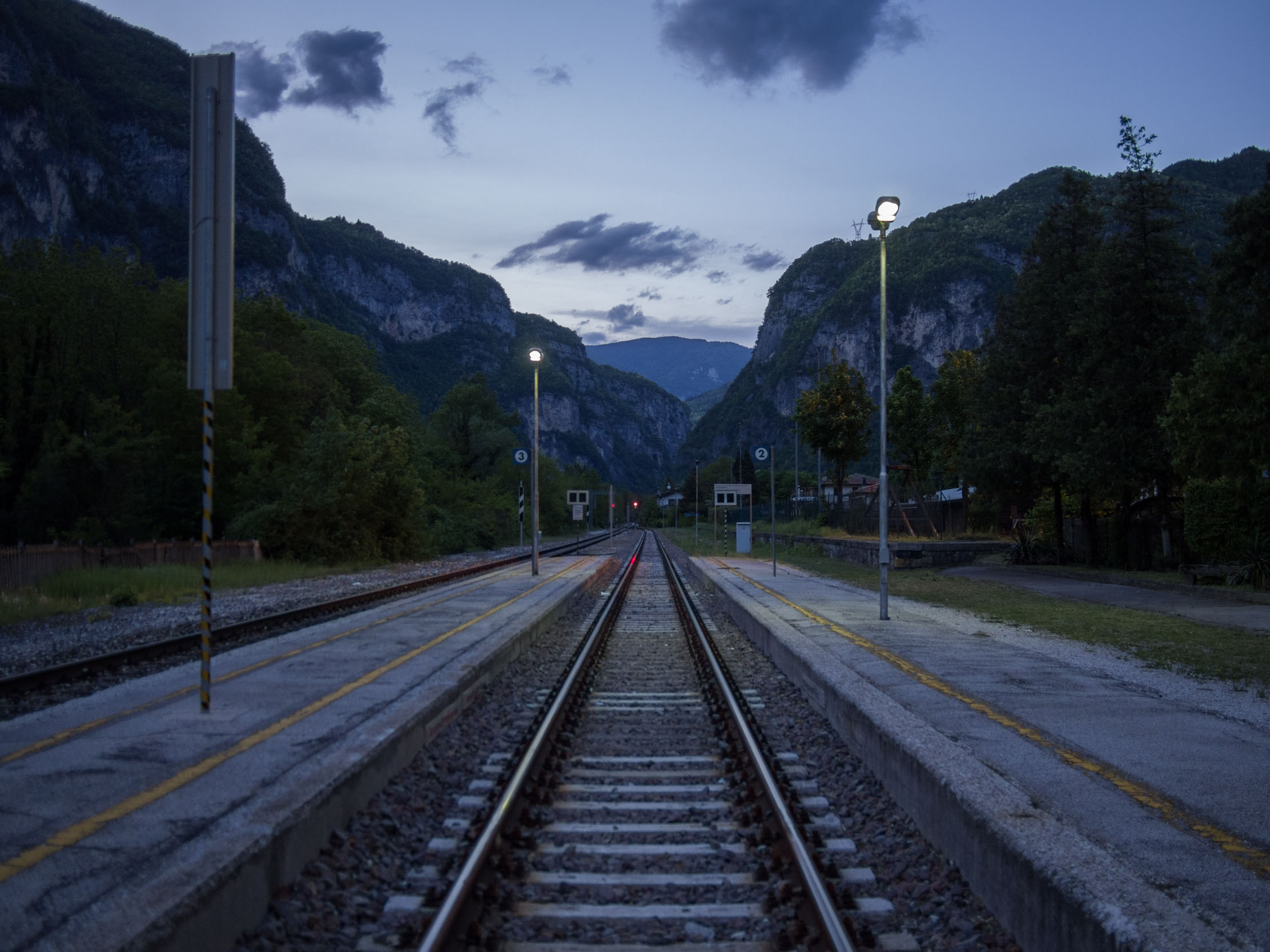
1910
To report the tragedy of Galindo Zancanaro: it was October 17 when his mother Elvira Nardino stood him on the edge of the fountain in the piazza (which still exists, but in a different form), the toddler slipped from his mother’s hands and he fell to the bottom. He was immediately recovered, but his life was lost. Two days earlier he had turned 3 years old.

Also in 1910 the first death from pellagra is reported, striking Modesto Grando, 71 years old.
1911
On December 8, the first pair of twins is born in Incino. They are Giovanni and Antonio Zancanaro but they will die 2 days later from insufficient vitality. A second pair of twins will be born in Tanisoi on May 15, 1917, Secondina and Maria Grando. Secondina will live 31 days and will die from bronchial pneumonia. Maria will live 5 days longer and die from intestinal fever. A third pair of twins are Maria and Giuseppina Nardino, daughters of Florindo and Antonia Borsa. They are born on June 21, 1924 and die the same day from insufficient vitality.
1916
The first electrocution death is Camillo Zancanaro, 9 years old. “Burned by electrical current from climbing on top of a light pole,” as reported in the death register.
Taking stock: The average lifespan throughout the Kingdom of Italy was less than 40 at the beginning of the century, which was due to startling infant mortality. For men who reached 65, that was a ripe old age. For women, the average was 68–70 years old. The first 90-year-olds only appeared after 1940. The most common causes of death were, in order:
- Respiratory causes (bronchitis, bronchial pneumonia, tuberculosis, and asthma, with the cases of bronchitis triple those of bronchial pneumonia)
- Senile marasmus (this will later be called arteriosclerosis and now Alzheimer’s disease)
- Typhus
- Meningitis
- Slow consumption (starvation)
There were few deaths from heart attacks: heart attacks were unknown—maybe they would have been called “instantaneous illness” or “sudden ailment.” A couple deaths from collapse are registered, plus some deaths from more-or-less-progressive paralysis. Only after the Great War, in spite of the devastation and hardship, does child mortality slow down markedly.
From The Chronicles of the Curacy, vol. 1–2
In the time before the church, these good Christians had built a small wood-gated shrine where the niche of the Sacred Heart now stands. On one side was a basin for holy water; on the other was an alms box. Beside the offerings, an oil lamp burned day and night in front of the Madonna del Pedancino painted on the center wall, along with San Rocco and Saint Anthony on the two side walls.
Every evening, though tired from the day’s work, the good believers of the little alpine village would gather to recite the rosary and sing the praises of the Virgin. Here the rogation processions would stop on their way from Rocca, there they would gather for communion on Easter with Rocca’s pastor or chaplain.
Since Incino was far from the parish church in Rocca (around 4 kilometers) and connected by a mule path that was terrible in winter and fraught with danger from avalanches, a church for Incino (which then had 516 residents) was proposed at almost the same time that they were thinking of raising Rocca’s parish church up on the hills. When instead the parish church was built in its present position, the idea of a church in Incino was embraced even more.
Rocks, sand, lime, beams, and construction equipment were stockpiled in great quantities on Drio el Col, where the new church was to be built.

In fact, this is where the envoy of Bishop Monsignor Callegari blessed and laid the first stone, which contained a special recess for various coins (including one of Pope Pius IX), medals, a parchment, and an image of Sant’Alfonso Maria de Liguori, for whom the population harbored a special reverence.
Most of Rocca mocked and ridiculed Incino’s plan for its own church and priest. But not pastor Don Luigi Moccellini, who championed the initiative in every way, and even gave Incino the bell that was used to call the people to work and prayer. Gio-Batta Zancanaro (“Marinel”) was the one who carried it to Incino, amid a crowd of children knocking it with rocks and tools on the road to make it ring.
The proposal to build the church on Drio el Col was later abandoned largely since the site was too exposed to the wind currents from Val Cismon and because it got no sun exposure for many months. Whereby the first stone, blessed and laid once before, was dug up and brought in a procession to the current site of the church. It was placed at the corner on a noon long ago, around a meter from the front corner of Antonio “Boridon” Zancanaro’s cottage. The land was donated to the parish council by Michele Zancanaro, son of the late Giuseppe, and Elisabetta Zancanaro, married-name Nardino.
Excavation started on November 21st, 1896, a date that wasn’t chosen accidentally—that was the day of the liturgical feast the Presentation of Mary to the Temple. In the Veneto the celebration is known as Madonna della Salute, or Madonna of Health, the legacy of a 1630 vow from the Veneto to the Virgin to end their terrible plague. The first stone was then re-blessed by Pastor Don Luigi Mocellini, aided by Chaplain Don Giuseppe Destro, who was also the schoolmaster.
To plan and supervise the construction, the men of Incino went to Arsiè to ask the engineer Giovanni Ivanoff for help.
Engineer Ivanoff was born in 1851 to a Russian family in Trieste, graduated in military engineering, befriended irredentist Italian students including Guglielmo Oberdan—and together they plotted an attempt on the life of the Austrian emperor, which was exposed. To avoid arrest and a certain death sentence, Ivanoff fled to Italy, moving to Arsiè where he married Emma Fusinato and settled down.
Given Ivanoff’s expertise in military construction—and likely aware of Austria’s fortification plans for its borders—he was hired by the Genio, the Italian Military Corps of Engineers. Between 1882 and 1910 he planned and supervised construction on the forts of Fastro and Cima Campo, as well as works around Belluno, on the tracciato della Cavallera [link in Italian], and the campanile of the church in Rocca.
He accepted the request for help and drew up plans for Incino’s church and campanile, but with commitments in Fastro he couldn’t always be present, so a construction manager was appointed: the proponent of the idea, Francesco Nardino, known as Checco Menegai, took the job, aided by Antonio Nardino, known as Sante.
Engineer Ivanoff came to Incino to check the progress of the work nearly every Sunday until it was finished, without asking for any pay. Later on (around 1910), Ivanoff will return to Incino to plan and supervise the construction of the Pala della Renga Road. He died in 1917 in Arsiè, and his remains lie in the cemetery there.
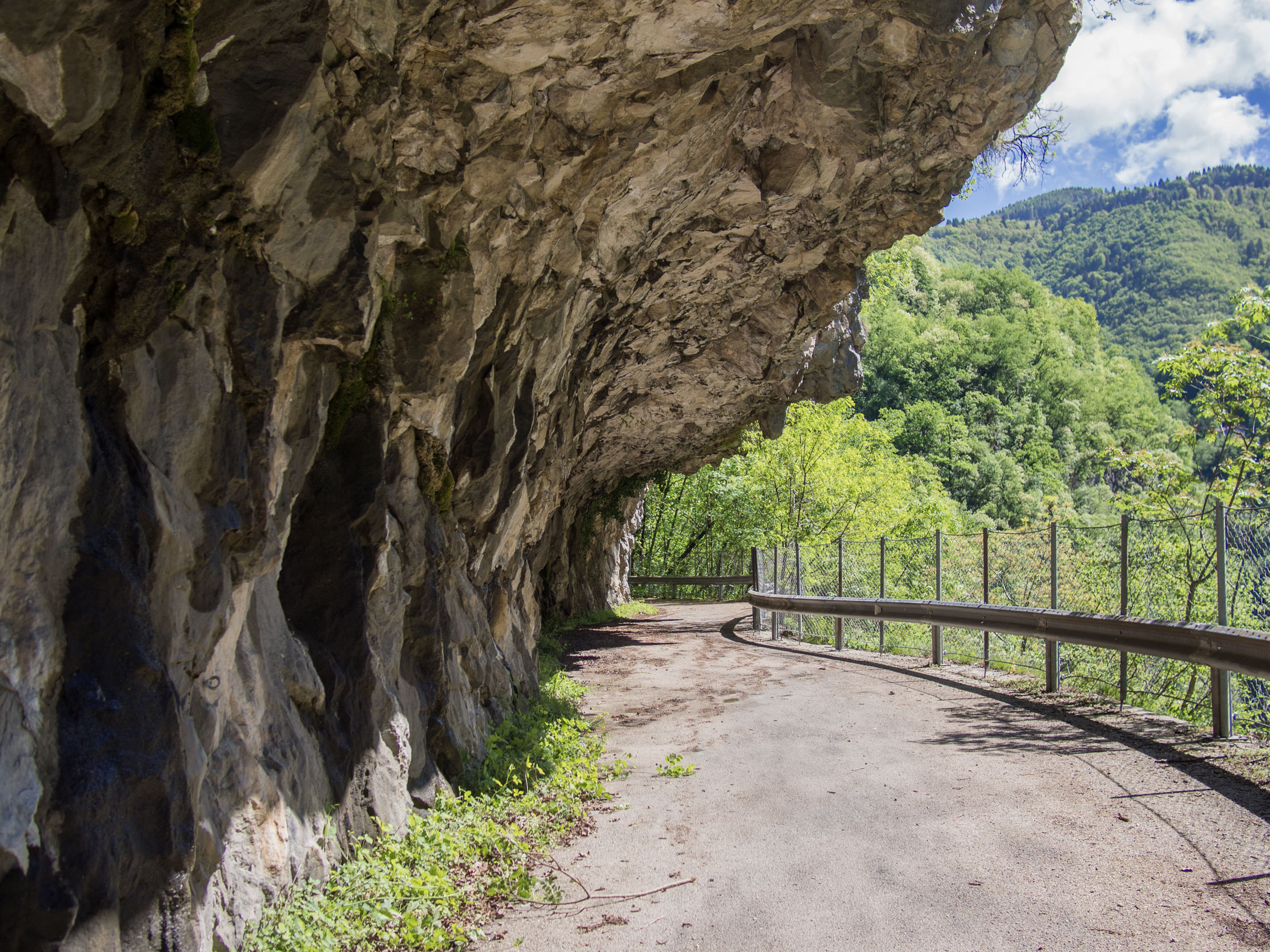
In these years Incino was a migratory village, since what little arable land there was couldn’t support the population, and accordingly from the ages of 12 or 13, everyone emigrated abroad, particularly to France, Switzerland, America, and even today in 1940 they would emigrate if passage were free. But for the whole season of 1900–1901, Valentino Zancanaro from Prai and Giacomo Zancanaro from Casere (son of the late Felice) stayed behind, and aided by Domenico Zancanaro (“Cici”) they led almost all the construction up to the cornice—including the campanile, which rose in step with the church.
These workers had been commissioned by the parishioners to continue the work for a respectable daily wage. The whole population was mobilized so construction materials wouldn’t run out, and you would see women, young girls, little boys, hauling down large beams from Lisser, from the mountains of Cismon, from Arsiè, moving stones from the quarry owned by Domenico Appolina Zancanaro and Pietro dei Conchi Nardino, bringing up grit from the hillside and sand for the stucco.
The first dead man brought into the church, which was still not completed and not yet holding funerals, was Fortunato Borsa (“Bani”). A club and a deck of playing cards were placed in his coffin, so great was his passion was for this amusement.
1902
For the whole year the parishioners worked eagerly and nonstop, so that by December 13, the Feast of Saint Lucia, the last tile could be laid on the roof. On that day, Giovanni Nardino (“Conco”) was brought to his grave in Rocca as snow fell in broad flakes.
The church had no plaster, no ceiling, only temporary doors, and an improvised brick altar missing its altar stone. It was completely bare. Its first religious painting was of Sant’Alfonso de Ligouri, given by Antonio Nardino and was hung on the wall over the men’s door where it remained until recently. The work had to be finished, especially the choir, which was immediately given a ceiling and properly plastered, though only with coarse sand.
1903
On November 21, to honor the Madonna della Salute, whose patronage inspired this colossal effort, the first mass was celebrated by Rocca’s pastor Don Luigi Moccellini, aided by the chaplain and by the archpriest of Arsiè Don Valentino Balasso. The Schola Cantorum of San Vito sang. The people came in huge numbers from the neighboring villages; constant fireworks enthralled a poor and simple population that had never seen such wonders.
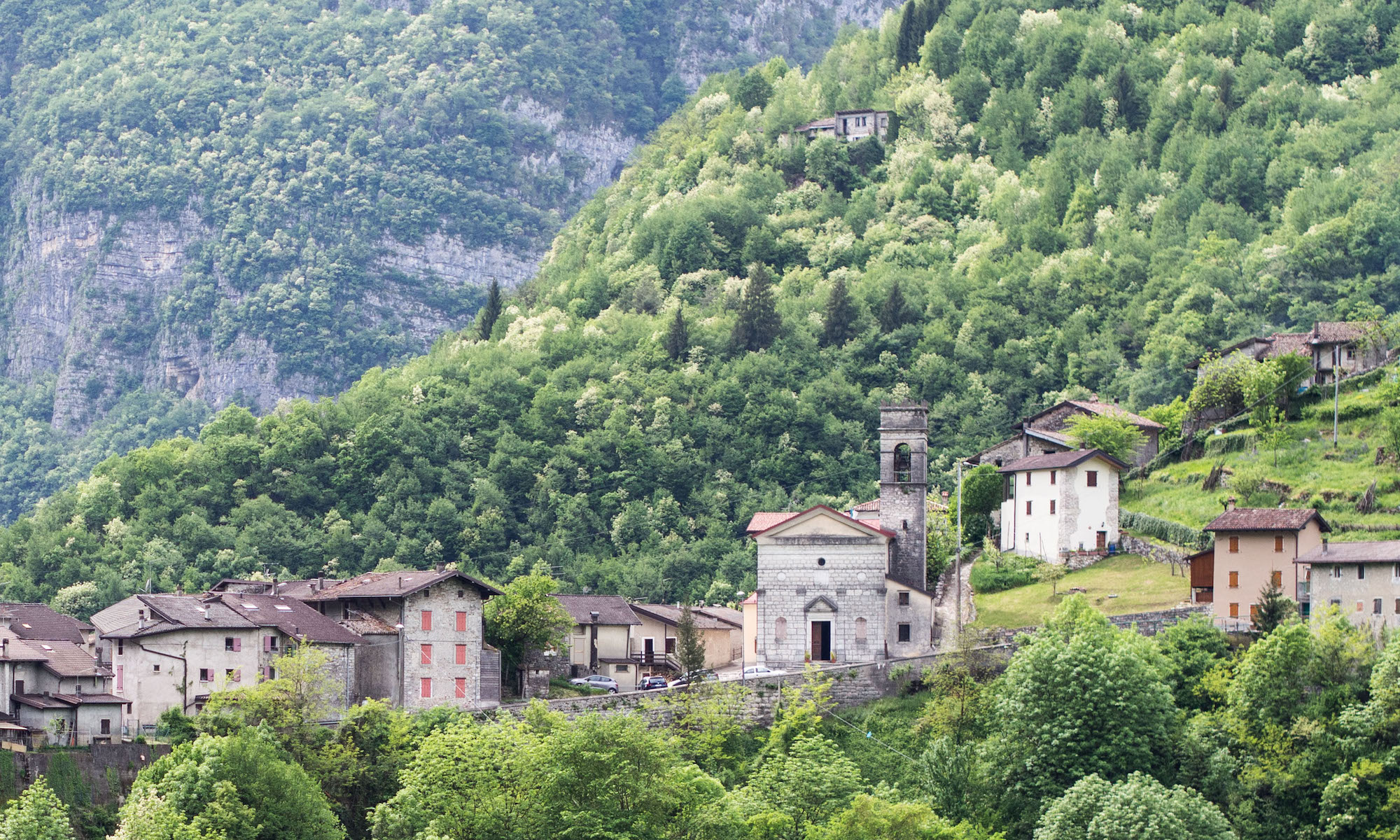
A group of miners from Incino who encountered unspeakable dangers on Monte Bianco returned safe and sound. They credited their salvation to Santa Barbara, and promised to establish a cult to her in their village.
Indeed, when they returned home on December 4, 1902, they wanted a solemn mass sung in her honor, which was celebrated by Don Angelo Fincato from Cismon. A quintal and a half of powder was used to fire mortars from the highest and most conspicuous sites in the village; fire and fireworks broke the darkness of night.
It ought to be remembered though that neither the chapel nor the statue of Santa Barbara were yet in existence.
For almost a year priests came to celebrate mass on Sundays, from Arsiè, then Rocca, then Enego, then Don Cirillo from Collicello with his straw hat and his hobnailed shoes—which he entrusted right away to Battistina Grando (daughter of Michele)—with coffee, wine, and bread in abundance. Each time the officiating priest was paid an offering of 5 lire.
Around this time the village leaders approached the Bishop of Padua for a permanent priest, and after securing an annual endowment of 2,000 lire, underwritten by all the heads of households, the novice priest Don Girardi Baldassarre was sent to Incino as its first curate. It was August 18, 1905.
He was accompanied to the village by both priests from Rocca, and he was welcomed here amid cheers and applause, amid firing mortars and the sound of the little bell that today is rung for threatening storms and misfortune (indeed, the other bells were not yet there).
Mass was solemnly sung in thirds, then a lavish banquet was prepared by Giuseppe Zancanaro (son of the late Michele) in the Baribon house. 17 people came, the foremost representatives of the village—everyone else was abroad for work. The curate was sleeping and eating for the moment in the home of Giovanni Nardino (“Tavernel”), son of the late Giacomo. He stayed for over 2 years since the old parsonage hadn’t yet been built.
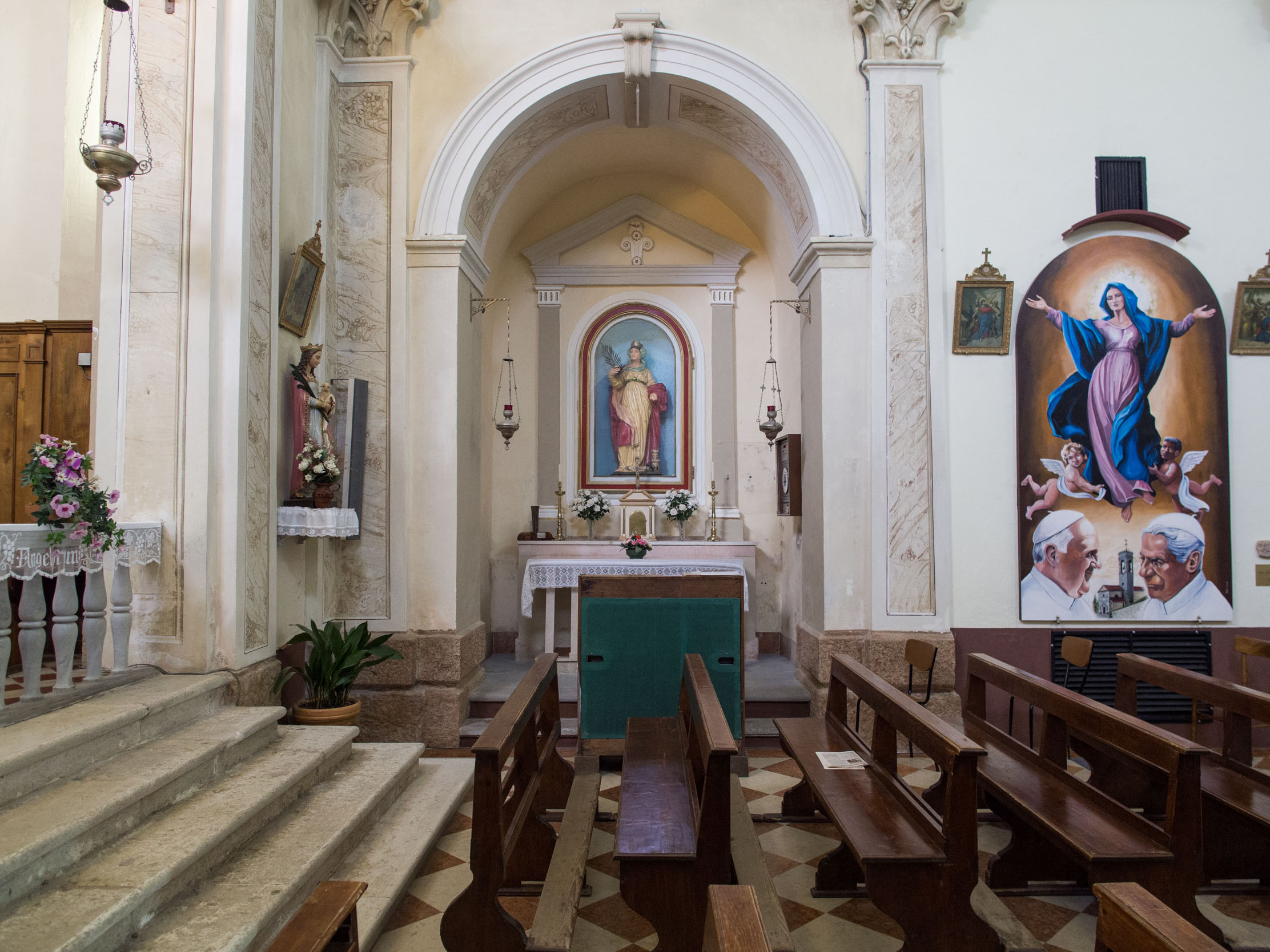
In the meantime, the whole interior of the church was set up. The chapel of Santa Barbara was built, whose statue was donated by all of the miners. The image of the Madonna della Salute was purchased as well, to whom the church was dedicated, in addition to the great crucifix, whose arm was split by a grenade from a 149 cannon during the war and was brought to safety in Casere along with the other sacred objects in the house of Luigi Zancanaro (son of the late Felice).
The paintings of the Stations of the Cross were purchased, and finally work was begun on the parsonage, whose site was occupied by the house of Sebastiano Zancanaro (son of Arcangelo). Directing the work, done all through free labor, was the zealous priest Don Girardi Baldassare, who had the luck of living there for almost 3 years. To build the water tank, Luigi Zancanaro (son of the late Felice) worked no small amount.
The Campanile

We have said that while the work on the church was progressing, so too was the campanile, which in 1905 could be considered complete. It was 20 meters high, like today, only it was topped by a zinc-covered pyramid, on which a cross was placed by Luigi Zancanaro (son of the late Felice).
The bells were the work of the Cobalchini di Bassano Company, weighing 6.80 quintals in all. They were towed to the village over the frozen Genio military road, then over Via dei Foram. They were brought into the church and they sat for several months until the curate baptized them “de licentia—episcopi,” under license of the bishop.
The small one was given the name of Santa Barbara on behalf of its sponsor Michele Zancanaro, the middle one was given the name of Saint Anthony on behalf of its sponsor Giuseppe Zancanaro (son of Giovanni), and the third was given the name of Santa Maria on behalf of its sponsor Michele Grando. It was winter, 1906.
The bell castle and the two door knockers were the work of a certain Francesco Cerato from Enego. With wooden scaffolding, he built a kind of platform connecting the house of Maria Zancanaro (“Pataco”) with the belfry, on top of which the bells were hauled to their places and blessed. The first to be rung, by Domenico Zancanaro (“Cici”), was the biggest, amid the excitement of all the population.
For several days they never stopped ringing. The first women who rang the bells were Battistina Grando and Giovanna and Elisa Baldassare, the curate’s sisters. It was the spring of 1907.
Don Girardi Baldassare was transferred to San Vito and Roveri in August, 1909 and was missed by all the Incinesi for his his goodness and considerable zeal, though there had been no shortage of trials and sorrows. His conscientiousness, his generosity, his selfless example, and his service to God and soul are remembered more than 30 years after his departure.
He was succeeded by Don Luigi Zolli, who had been in Cismon for 15 days. This priest, especially in the winter, loved to gather with the young and not-so-young for singing, for playing, and, quite naturally, also for drinking. The alms collection at the time yielded between 6 and 7 quintals of grapes per year.

In the following year, the church interior was plastered, and the confessional and the baptistery were built—the first baptism in the new font was for Primo Zancanaro, son of Domenico (“Cici”). During his tenure in Incino, Don Luigi bought a flag of the labor society, a symbol of harmony among the workers, who had a consumer mutual-aid cooperative.
Don Luigi Zolli was called to arms with the Red Cross in the spring of 1915. He was a good and affable priest—too much so, even, and some took advantage of him. For all 6 years of his tenure in Incino he lived in the old parsonage.
Whereby another event deserves attention:
1911
July
Don Modesto Zancanaro is consecrated priest. He is Incino’s first priest—history does not mention another before him. His first mass was a triumph, among Incino’s most emotional and wonderful events.
Also in the summer of of 1911, the Motu Proprio of Pope Pius X was read in church, which abolished the feasts of February 2 (The Purification of the Blessed Virgin Mary), March 19 (Saint Joseph), March 25, (The Annunciation of Mary), the second day of Easter, Pentecost Monday, the Feast of Corpus Christi, September 8 (The Nativity of Mary), and Saint Stephen’s Day. Some of these eliminated holidays will joyously return with the Concordat of 1929. But for Incino’s residents the disappointment was considerable—especially from the abolition of the feast of March 25, which wasn’t celebrated in the village but led the whole population to pour into Cismon, drawn to the great annual celebrations that are still kept alive in memory.
The choir was decorated by workers from San Vito, but later they presented an estimate of many thousands of lire, and workers from Seren were called in and their work pleased everyone; they were able to accomplish much more since there wasn’t much money available. The fields, hard-worked and fruitful, were producing twice as much as today (1940). The terraces were full of flowering vines, and each autumn the emigrants would bring back a tidy sum of money from abroad. Suffice it to say, there were 4 osterias in the village at the time and there was business in all of them.
At the beginning of the war, the statue of Sant’Agnese that was donated by the Daughters of Mary [link in Italian] was held for safekeeping in the house of Giuseppe Zancanaro, son of the late Luigi (“Cul”). The statue of Saint Anthony that was donated by Angelo Arcangelo Zancanaro was brought to Valentina Grando’s house. The image of Santa Libera was donated by all the women in the curacy. The miners wanted to donate an image of Santa Barbara to the church. The truly beautiful statue of Mary was brought to the village amid jubilation from the whole populace, who ran through the streets singing the praises and litanies of the Blessed Virgin, following the example and encouragement of Giacomo Telta.
1914
On August 8, the Brenta-Cismon Barricade Command was officially established. The commanding officer was Artillery Colonel Dino Roberto Guida, born 1856, retired 1914, and immediately called back to service due to the imminence of war. He was aided by Commanding Officer of the Genio Major Antonio Dal Fabbro, previously construction manager on the fortifications at Cima Campo, the Col Del Gallo, and Monte Lisser. Dal Fabbro was immediately appointed as director of the Arsiè-Incino-Cismon military road, which kept its military designation until 1931 when the township of Arsiè assumed responsibility for its maintenance.
Time of War
On May 24, 1915, Italy declared war on Austria. The day before, on Sunday, May 23, the day of Pentecost, the faithful of Incino, going to a large mass, found an ugly surprise hanging on the doors of the church: a notice posted by the Carabinieri mandating the general mobilization of all able-bodied men between the ages of 21 and 45.
The notice announced that the borders would be closed and passports withdrawn to prevent future soldiers from defecting.
In the spring of 1915 Don Luigi Zolli was called to arms, and the bishop sent no other priest in his place. On holidays, however, mass was celebrated just the same by Rocca’s pastor Don Busnella or by the subsistence military chaplains in Cismon, paid with a 5-lire offering and board from Battistina, Marinella’s daughter.
In October of 1916, Don Antonio Guerra was sent to Incino as curate. “Guerra” in name and in deed because, given his fiery temperament and the people’s unruliness, he didn’t stick around for long. Indeed, on Holy Saturday in 1917 his duties ended with the blessing of the holy font, during which there was an altercation between him and the bell-ringer Giovanni Zancanaro, son of the late Sebastiano and Bepi Tass (from the parish council), and he grabbed his suitcase and left for an unknown destination.
With the departure of the priest and Incino reduced to a small military fortress, the vestments and other sacred objects in the church were brought to safety. Felice Zancanaro in Casere took in the torches and the great crucifix she donated a few years prior, which was blessed by Don Antonio Pizzato in San Vito, when a grenade exploded and mutilated its arm. Santa Barbara’s hand was mangled as well. Flags, cloths, and vestments were brought to the house of Barbarina Zancanaro (Casere). Other furnishings were hidden in the Buso dei Sacconetti.
1917
The desperation of life in Incino is revealed in the tragic death of Sisto Grando from Pomer, 16 years old, his days brought to an end on June 18. “Hanging due to sudden madness from hunger,” writes Rocca’s pastor in the death register.
After the defeat of Caporetto and the rout at Piave, the Austrian enemy invaded the village of Incino on the evening of November 14.
Until that morning there had been two companies of the 6th Infantry stationed in Incino, plus a battery of 75-millimeter cannons, but at 8:00 A.M. General Donato Etna, commander of the XVIII Army Corps from the provisional command of Cismon (where he had been transferred from Arsiè), ordered these units to fall back to Cismon. The 9th Company of Gebirgsbrigate, after occupying the forts of the Col Del Gallo [link in Italian] and Prai and capturing 37 stragglers, descended around 5:30 P.M. and took Incino without any resistance.
From November of 1917, when the harsh Austrian Command established martial law over these poor people, nobody could imagine the pain, the fear, the deprivation, the abuse that was suffered, endured, kept silent. The church was struck by 3 grenades, reduced to a stable for horses who were so hungry they gnawed even on the doors, destroying them. The sacred paintings were scattered. The stations of the cross were burned. Almost everyone was displaced to the villages of the Feltrino, Alpago, Busche, Fonzaso…
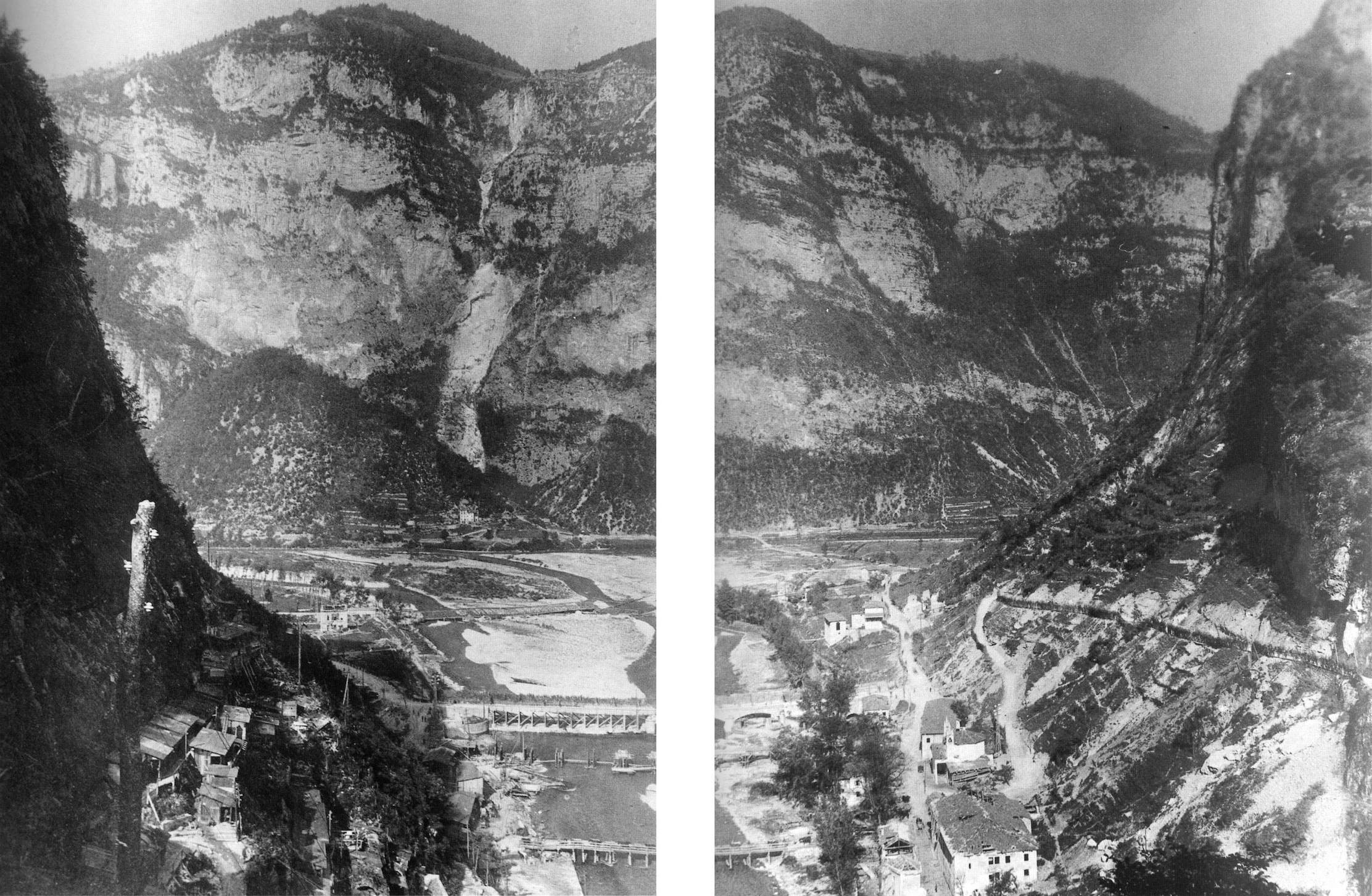
The Italians launched the first grenade to flush out the enemy around midnight on November 20—into the house of Giuseppe Zancanaro (“Iso”). Four soldiers and 12 animals died from the explosion and gas; 10 people were injured.
Miraculously, Valentina Zancanaro, her sister Maria, and her little son Pietro were unhurt. They immediately escaped to a nearby tunnel where they received first aid from German doctors, and were able to recover from the fright and take shelter from the poison gas.
Mary’s special protection toward the population of Incino was again revealed in the explosion of the great munitions stockpile. Filled with grenades, bombs, bullets, and gunpowder, and struck head-on by an Italian howitzer, it caught fire and in just minutes, with an explosion never felt on earth, went up in smoke. A vast number of houses crumbled or were completely demolished. 60 people were dead and over 200 injured. But of the civilians, the only death was Michele Zancanaro, along with 4 soldiers in the house of Giacomo Zancanaro (son of the late Giacomo Meneghet). Another 5 soldiers who went on to save Maria Meneghet Zancanaro died in the house of Antonio Zancanaro (son of the late Sebastiano) for the singular privilege of the Highest Power.
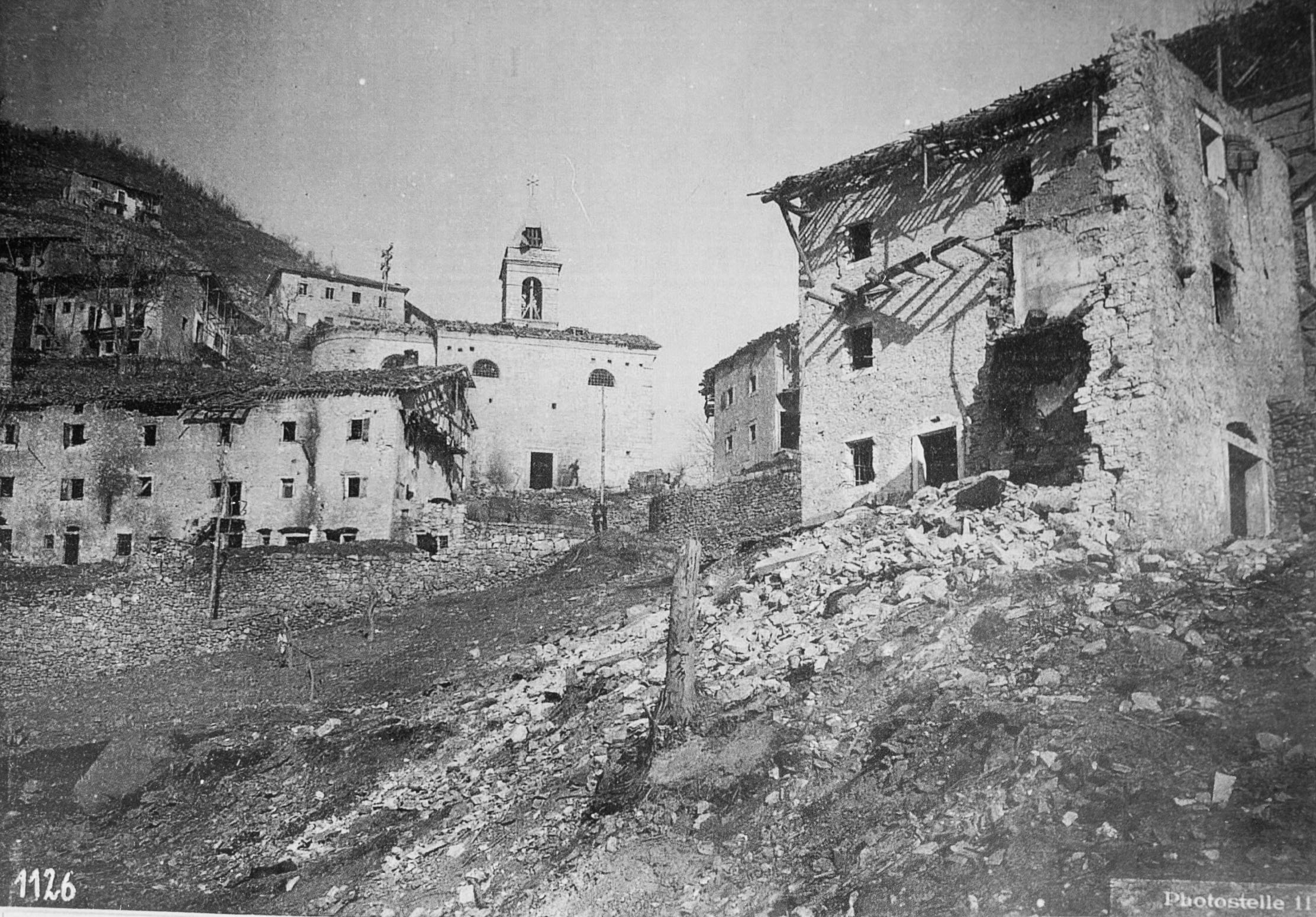
The poor people—under lethal gunfire, deafened by the rapid shooting of the 50 cannons and 100 machine guns on Incino’s hills—no longer felt safe, so they went into the tunnels, living on a handful of wild herbs.
The priest from Rocca didn’t dare accompany the departed Michele Zancanaro to his burial. Maria Nardino, 32 years old, wife of Luigi Strappazzon, was left to die with the son she was bringing into the world from “asphyxia of the birth mechanism,” since there was no medical care from Austrian doctors, and no one would risk summoning the civilian doctor from Piovega di Enego.
Another source of dread was the unexploded bombs that in particular would kill the young: on November 20, Domenico Zancanaro, 12 years old, was blown to pieces by a bomb he had stepped on; on February 11, 1918, two brothers, Albino and Antonio Martinato, 6 and 13 years old, died from the accidental detonation of an explosive, the same fate as Angelo Nardino, who died at age 10 on March 15, 1918.
1918
At the start of the year the Austrians built the narrow-gauge rail segment from Arsiè to Arten, which connected to the existing Feltre-Arten line. Arsiè’s station was found in Brolo by the cemetery. The Austrians also started work on the Pala della Renga to widen the Cismon-Incino Road for truck transit.
On February 1 in Incino, by order of Austrian Command, requisitioning began on all types of foodstuffs in civilian and military possession, with subsequent rationed distribution controlled by the Austrians. It was a year of severe deprivation for everyone.
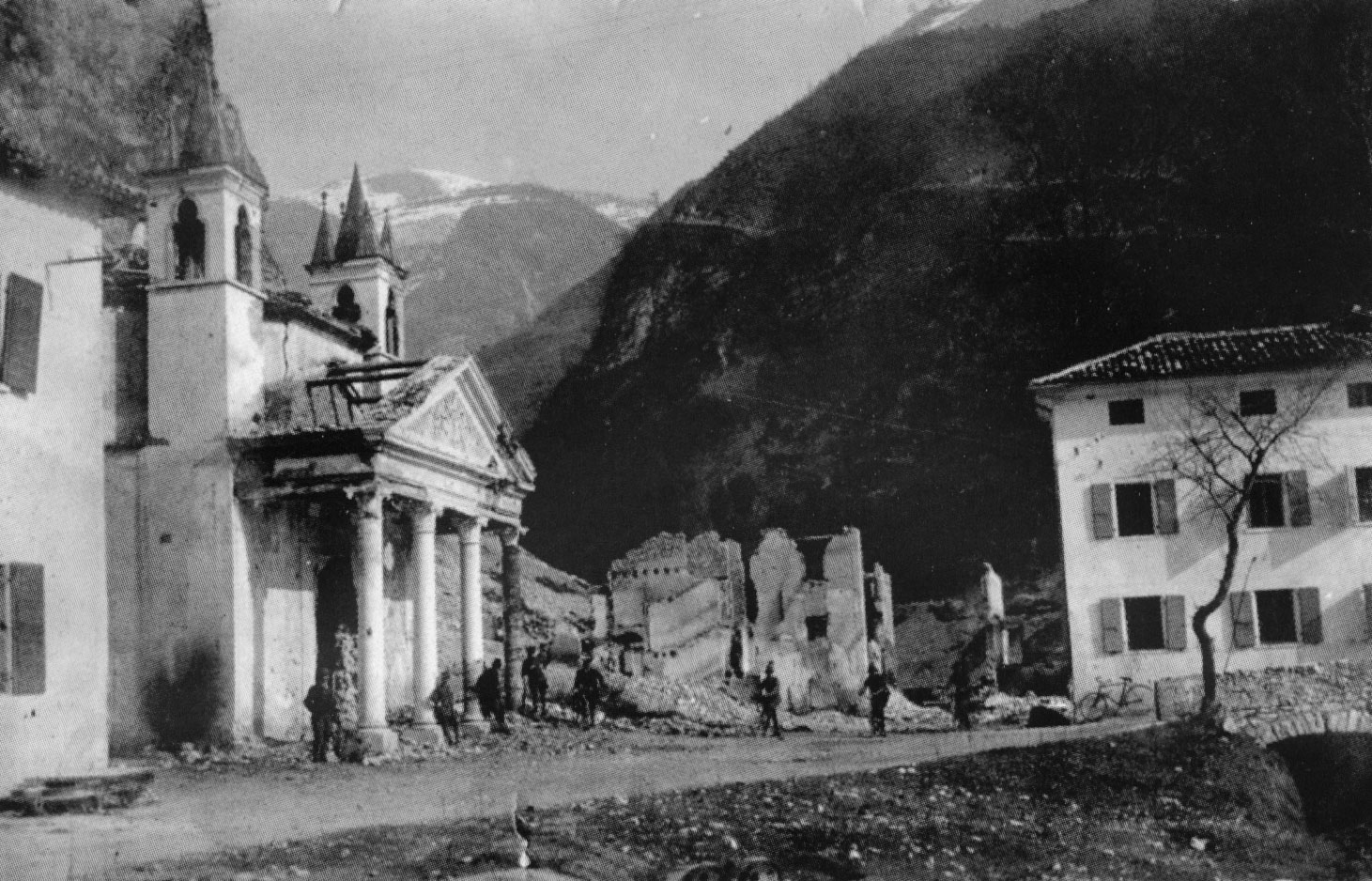
In the spring and summer of 1918 the situation reached a point of horrifying famine and destitution. The harvest in the fall of 1917 had been extremely abundant, and by October houses were well stocked with provisions. But after a few weeks of Austrian occupation everything was gone—from repeated requisitioning, looting, theft, and expropriation, which was impossible to contest.
The requisitioning, with notices posted everywhere, applied to horses, automobiles (of which there were none), but cows and goats (only one cow or goat was authorized per family), all hens were commandeered, wool garments, blankets. Two sheets were allowed per person and one pot per family. The residents were forced to comply as the Austrians threatened to deport the most prominent members of the village if their orders were not immediately obeyed.
Dire famine caused at least 100 starvation deaths in the township of Arsiè. Fortunately, the mild winter permitted herbs (dandelions) to grow early, which were crucial for many people’s survival. There was no mushroom gathering because no one knew which were edible and which were toxic, and going hungry was preferred to being poisoned.
Life was teeming with terror, tears, pain, and death, until November 2, 1918 when, following their victorious advance, the Alpini and the Arditi came down from Pegole and barricaded the road to the Austrian army, which was descending from Val Piana and Corlo in fleets of thousands and thousands.
Our heroes, in position with powerful machine guns, stopped the enemy, who were largely taken prisoner. They were commanded by Field Marshall Cesare De Vecchi (future Fascist Quadrumvir).
Note
Historical reality, however, is different: on that day at dawn, a patrol of 11 Arditi commanded by Corporal Pietro Nardino (“Gardelin”) from Incino managed, with a Fiat 14 machine gun, to block a path from Monte Grappa down to the Corlo Bridge, cutting off the lead battalion of the Austro-Hungarian brigade, which surrendered. But it wasn’t possible for Pietro Nardino to control such a large number of adversaries, even unarmed—soon the Arditi showed up from Cismon, under Commander De Vecchi, and took possession of the ~4,000 prisoners.
While Nardino’s actions were soon forgotten, in 1928 De Vecchi was awarded honorable citizenship in Bassano and Cismon for his deeds, as well as the noble title of “Count of Val Cismon.”
Pietro Nardino emigrated to France in 1924 and no more was heard of him.
On November 4, 1918, the long-awaited armistice arrived, marking the complete victory of our beloved sovereign Vittorio Emanuele III. To report the last of Incino’s fallen, the late Sebastiano Zancanaro (Meneghet), died in Milan in the late evening of November 3, 18 hours before the end of hostilities. He was the brother of Jovane.
Afterward the refugees began to repatriate—to see their loved ones, their land, their belongings again. But my God, what desolation, what destruction! In the village of Incino alone over 30 people died from weapons of war, from explosions, from hunger, from Spanish Flu.
The winter of 1918–1919 was spent taking refuge in crumbling houses. In the meantime Rocca’s pastor would often come on Sundays to celebrate holy mass.
At the beginning of 1918, while almost the entire population was displaced, the glorious bells, to the utmost grief of all, were thrown from the belfry and split apart. They were hauled off by the Austrians to be turned into war material. A fourth bell had been left in place as a signal to airplanes.
In the spring of 1918, a certain Don Giovanni Rizzolo arrived as curate, making his entrance to the village amid jubilation, accompanied by Cismon’s pastor. He stayed here barely a year but left an everlasting legacy for his simplicity and for the way he would deal with youngsters who were late to church on Sundays, calling out “Here come the fire brigades!”